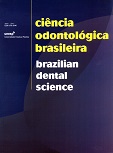Influence of varying light intensity on microleakage of Class II restorations
DOI:
https://doi.org/10.14295/bds.2003.v6i1.178Abstract
The purpose of this in vitro study was to evaluate the marginal microleakage of Class II restorations photo activated with varying light intensity. Class II preparations with gingival margins were made in 80 sound human third molars. The teeth were divided into 2 groups and restored with two different resin composites (P60 and Z100). Each group was further subdivided into four subgroups, which were submitted to distinct light intensity during the polymerization process. Groups 1A and 1B received a light intensity of 550 mW/cm2 in each of the three layers. Groups 2A and 2B received an exponential light intensity from 0 to 600 mW/cm2 in each layer. Groups 3A and 3B received 300 mW/cm2 in the first layer and 550 mW/cm2 in the other two layers. Groups 4A and 4B were submitted to a light intensity of 100 mW/cm2 for 10 seconds followed by 550 mW/cm2 for 30 seconds in each layer. The specimens were immersed in a 2% buffered aqueous solution of methylene blue for 2 hours. The penetration of the dye was then measured under a stereomicroscope with X20 magnification. Data were submitted to the Kruskall-Wallis test and results demonstrated no statistically significant differences between the groups when differentiated by the resin composites or the light intensity, at a p-value of 0.05. In conclusion, the variation in light intensity did not significantly affect the marginal microleakage of the resin composites tested.Downloads
Downloads
Published
How to Cite
Issue
Section
License
Brazilian Dental Science uses the Creative Commons (CC-BY 4.0) license, thus preserving the integrity of articles in an open access environment. The journal allows the author to retain publishing rights without restrictions.
=================




























